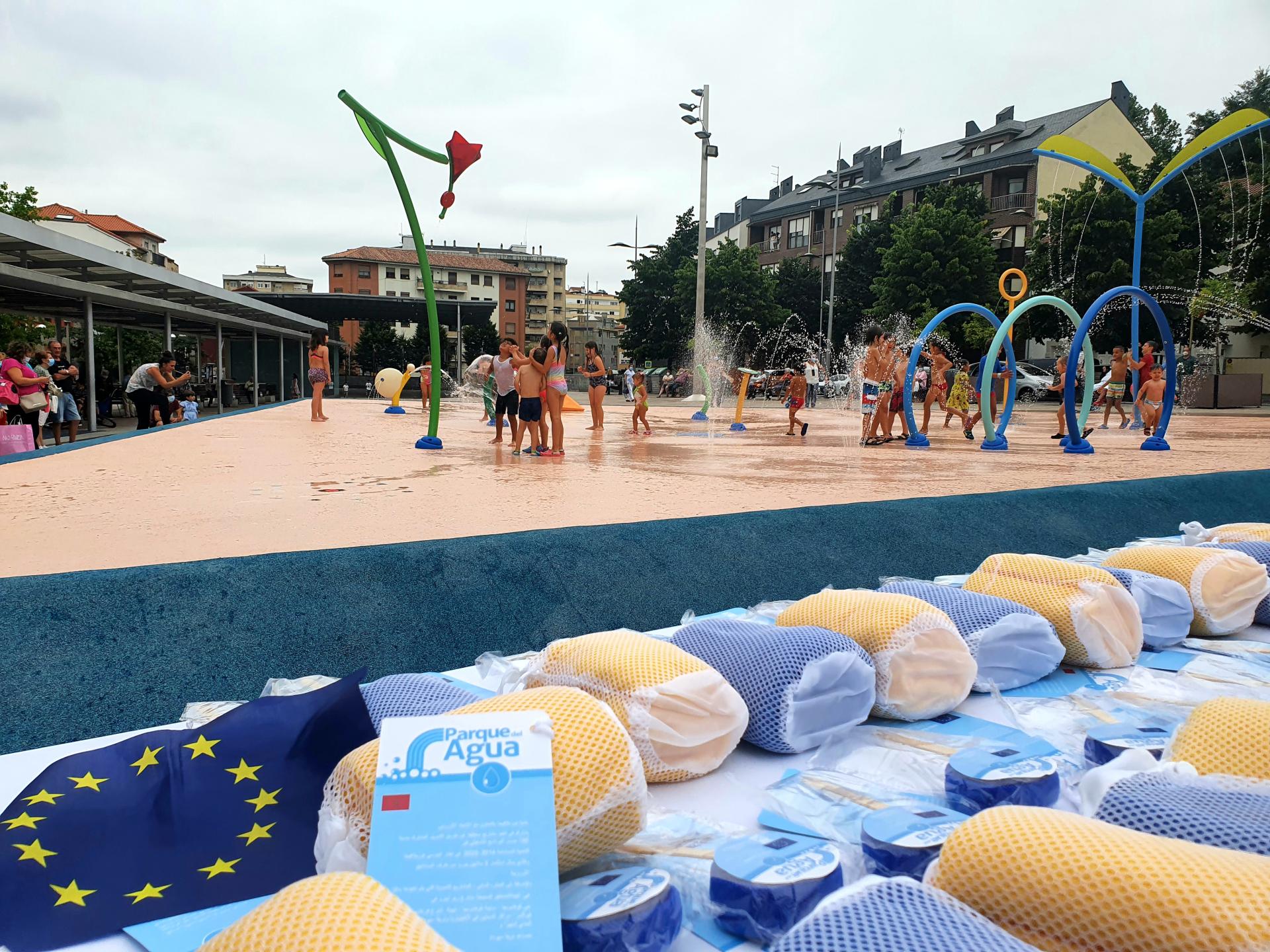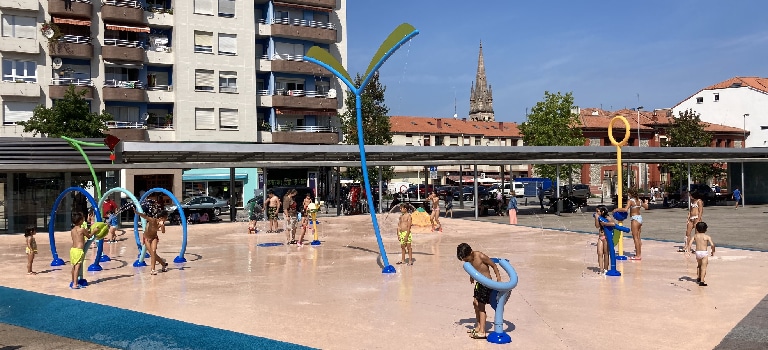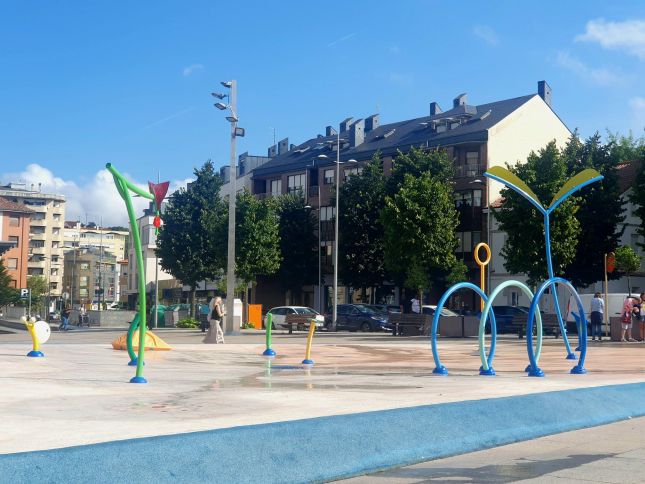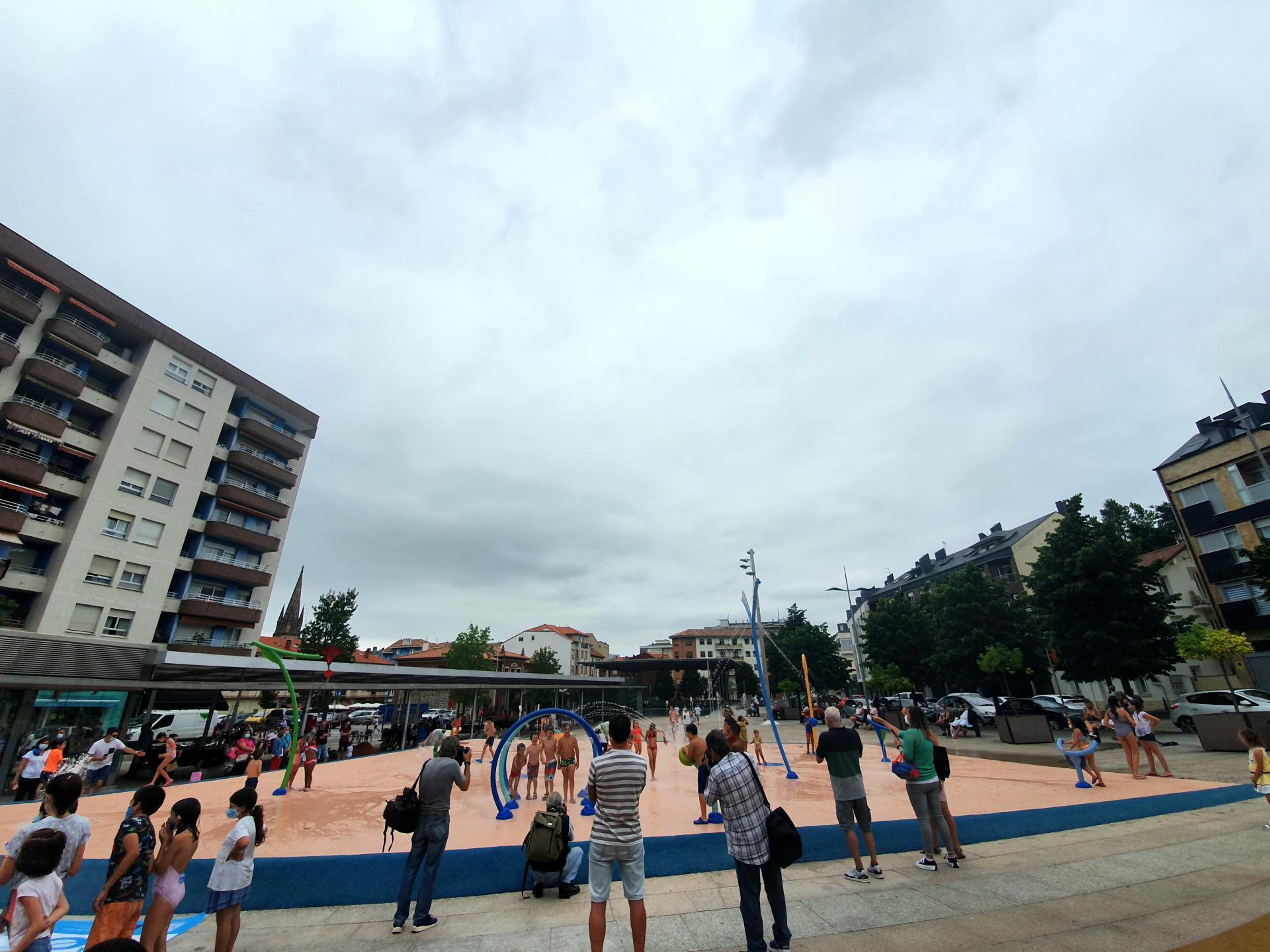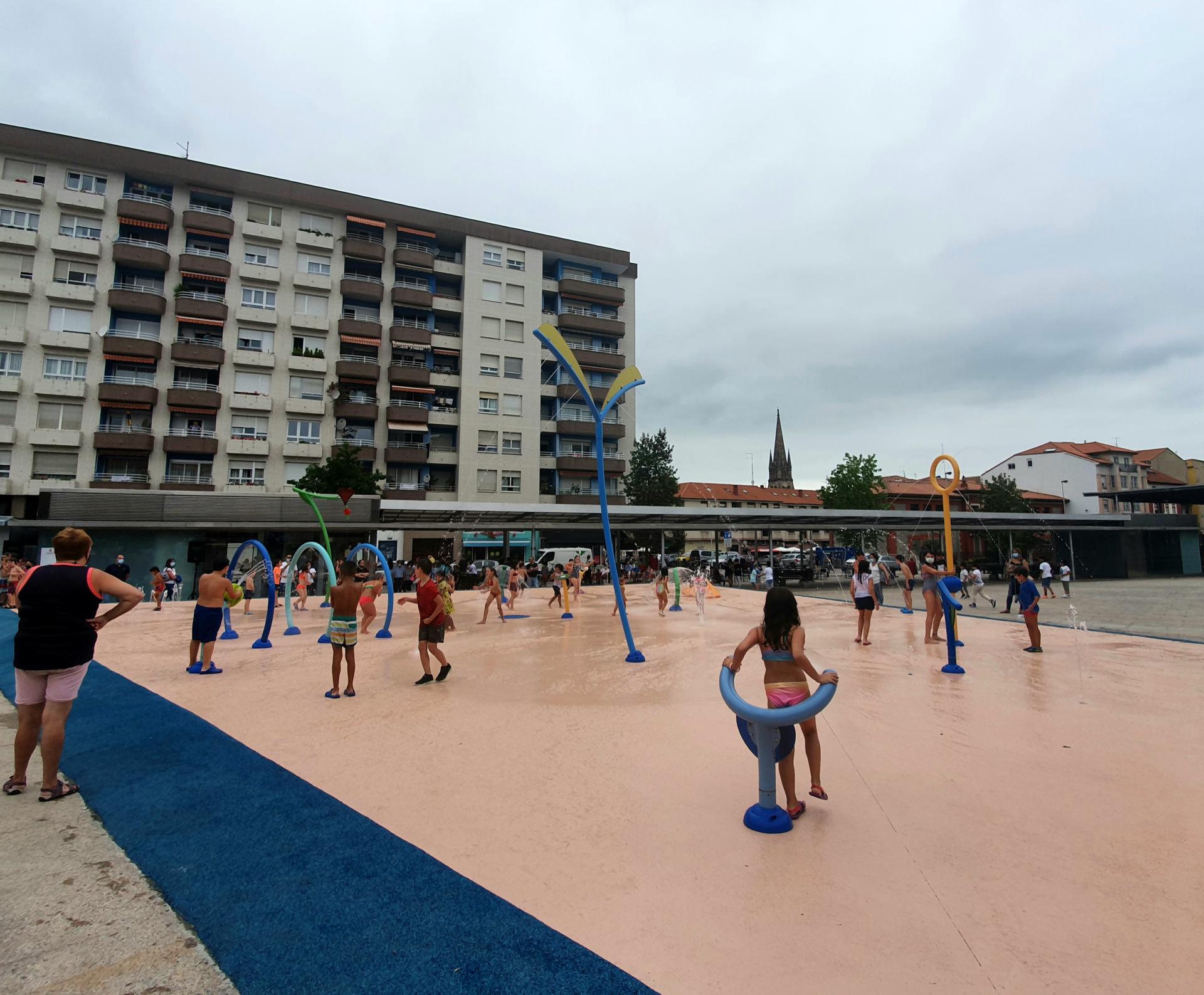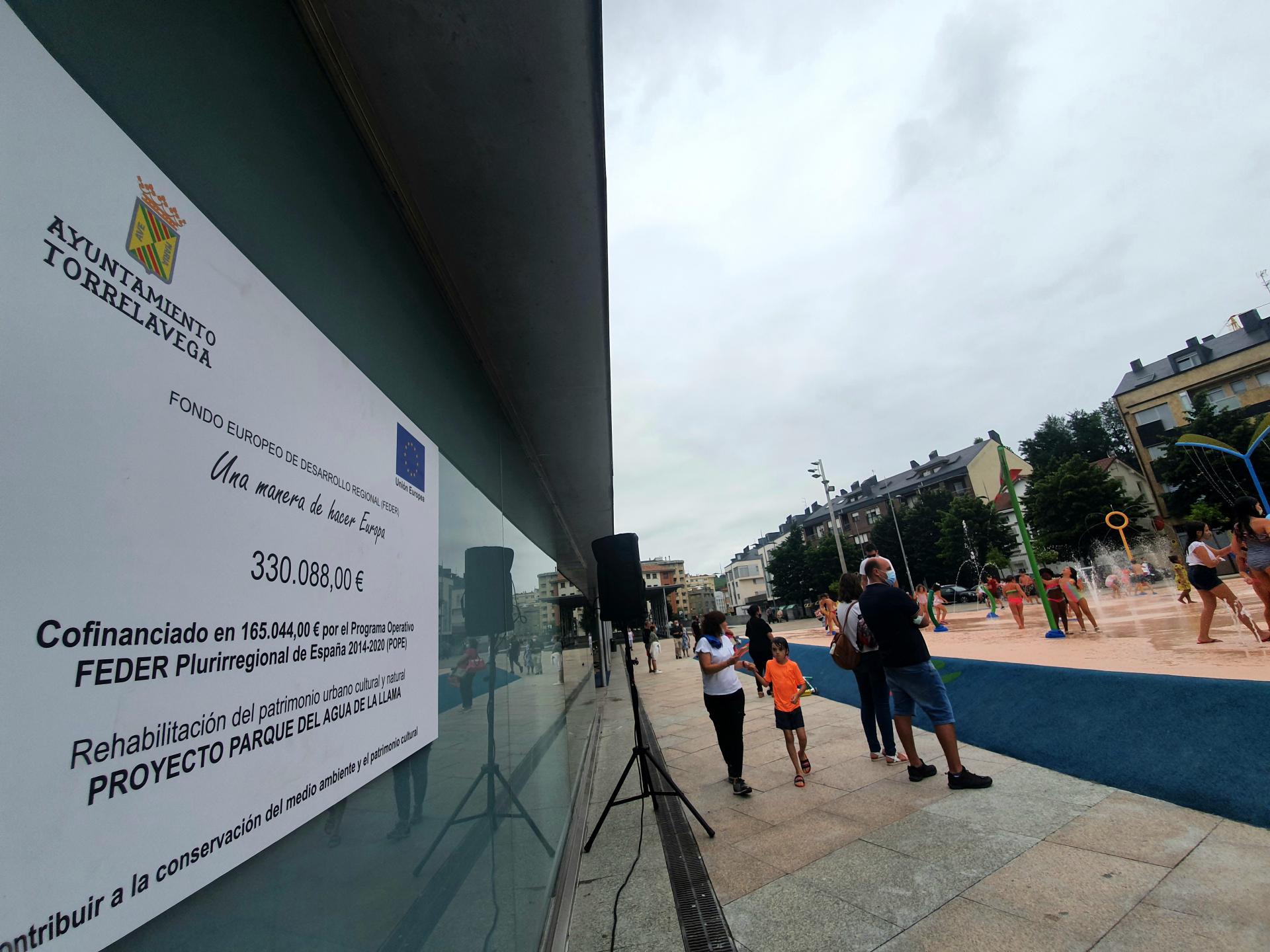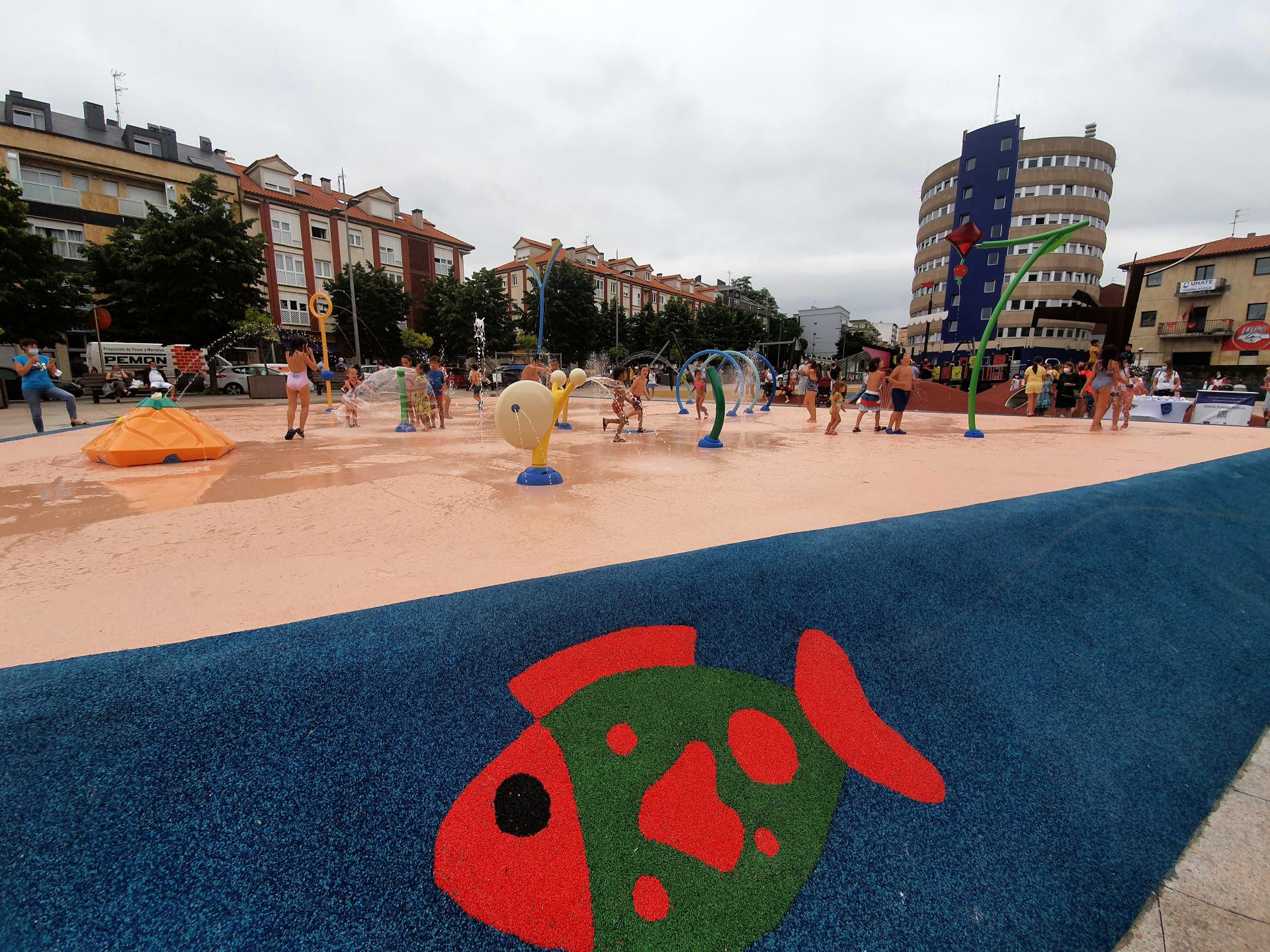La Llama Waterpark
Basic information
Project Title
La Llama Waterpark
Full project title
The transformation of La Llama Square through a waterpark
Category
Prioritising the places and people that need it the most
Project Description
La Llama Waterpark is an attempt to democratize acuatic leisure in an age where the expansion of private pools is getting more and more common. Through the waterpark, the city of Torrelavega has revived one of its main squares as well, Plaza de La Llama, located in a neighborhood historically known by inmigration, segregation, conflicts and spiritually separated from the rest of the city. La Llama now acts as a link between both sides, attracting people of all ages and upbringings
Geographical Scope
Local
Project Region
Torrelavega, Spain
Urban or rural issues
Mainly urban
Physical or other transformations
It refers to a physical transformation of the built environment (hard investment)
EU Programme or fund
Yes
Which funds
ERDF : European Regional Development Fund
Description of the project
Summary
In his book ‘La España de las Piscinas’, Jorge Dioni tries to explain how urbanism in Spain has changed its political map based on the results of the 2019 elections. In that sense, Dioni exposes the fact that the outskirts of important cities like Madrid have been conquered by invididual properties for middle-aged couples, sometimes with little children, but always with the same link for every property: a private pool.
The pool is the symbol through which Dioni explains the fact that neoliberalism has found its niche in this locations, creating a new way of showing power and status. Based on this idea, La Llama Waterpark is meant to democratize acuatic leisure while also serving as a way to recover an emblematic square in Torrelavega.
The waterpark has transformed this space in order to unify the city center with La Inmobiliaria neighborhood, a district historically marked by inmigration, isolation and conflictivity. The waterpark project was accompanied by others like a playground and a pergola on one side of the square to create a friendly environment for people of all ages.
Now, what once was an empty space has become a meeting point for people from all over Torrelavega, a link between different cultures and ages. It has also provided a free alternative for the lower classes to enjoy acuatic leisure, in a city without beach or a public pool, at least until 2023.
While obviously the target group for such a park are kids, its inception has given an influx of life to the square and its surroundings, propelling new restaurants and bars, a candy store and other shops. Kids and adults enjoy themselves in their own way in a new interconnected environment meant for everybody.
Not only is this a summer thing, as the elements in the waterpark are retired during winter and the elevated space is used for other activities such as fitness or dancing classes.
The pool is the symbol through which Dioni explains the fact that neoliberalism has found its niche in this locations, creating a new way of showing power and status. Based on this idea, La Llama Waterpark is meant to democratize acuatic leisure while also serving as a way to recover an emblematic square in Torrelavega.
The waterpark has transformed this space in order to unify the city center with La Inmobiliaria neighborhood, a district historically marked by inmigration, isolation and conflictivity. The waterpark project was accompanied by others like a playground and a pergola on one side of the square to create a friendly environment for people of all ages.
Now, what once was an empty space has become a meeting point for people from all over Torrelavega, a link between different cultures and ages. It has also provided a free alternative for the lower classes to enjoy acuatic leisure, in a city without beach or a public pool, at least until 2023.
While obviously the target group for such a park are kids, its inception has given an influx of life to the square and its surroundings, propelling new restaurants and bars, a candy store and other shops. Kids and adults enjoy themselves in their own way in a new interconnected environment meant for everybody.
Not only is this a summer thing, as the elements in the waterpark are retired during winter and the elevated space is used for other activities such as fitness or dancing classes.
Key objectives for sustainability
The sustainability of the project is based on three main aspects. First, and probably the most important of all given the nature of the water, the recycling of water. The waterpark uses a closed circuit of water where the same water is always reused. Everything thrown by the elements in the park is recovered through the ground, cleaned and reused all over the day, thus reducing the need to refill with loads of water every few days.
Also, the waterpark has given a local alternative to families who want to enjoy water leisure. Before that, people in Torrelavega had to move to other towns or cities like Suances, Cartes or Puente San Miguel, where they have pools or beaches. Because of this, we have reduced the use of private and public transport.
As stated before, the last aspect would be the temporality of the water elements. Once summer is over, those are removed in order to leave an open, elevated space which is used through the year for many different activities.
With summer getting longer and longer, the waterpark has turned out to be a great option for an interior city like Torrelavega. While traditional summer months like July and August are still dominated by the beaches, the waterpark marks an earlier start to fight the heat, and a latter finish. The June to September season has seen the waterpark operative, basically a third of the year, and even going into October in 2023.
Torrelavega is a great example for other cities in the north of Spain, where temperatures tend to be warmer than hotter and some days, it is preferred to refresh yourself for a bit rather than spending the day on the beach. In Cantabria, another town like Camargo has replicated the waterpark to a smaller scale but to great success as well.
Also, the waterpark has given a local alternative to families who want to enjoy water leisure. Before that, people in Torrelavega had to move to other towns or cities like Suances, Cartes or Puente San Miguel, where they have pools or beaches. Because of this, we have reduced the use of private and public transport.
As stated before, the last aspect would be the temporality of the water elements. Once summer is over, those are removed in order to leave an open, elevated space which is used through the year for many different activities.
With summer getting longer and longer, the waterpark has turned out to be a great option for an interior city like Torrelavega. While traditional summer months like July and August are still dominated by the beaches, the waterpark marks an earlier start to fight the heat, and a latter finish. The June to September season has seen the waterpark operative, basically a third of the year, and even going into October in 2023.
Torrelavega is a great example for other cities in the north of Spain, where temperatures tend to be warmer than hotter and some days, it is preferred to refresh yourself for a bit rather than spending the day on the beach. In Cantabria, another town like Camargo has replicated the waterpark to a smaller scale but to great success as well.
Key objectives for aesthetics and quality
Aesthetics were never the focal point of this project, as it was thought in a more practical manner in order to get the most of the space used. However, some aspects are worth mentioning.
The water and acuatic theme is followed through the square, creating synergies between the waterpark and the traditional park. The latter is centered around a pirate ship and other similar elements to enhance that piracy experience.
Apart from that, all elements in the waterpark are defined by its colorfulness. This aspect is really self-explanatory, as it is meant to enhance the enjoyment of the kids and children using the waterpark, with bright, warm and shiny colors on every element of the waterpark.
All in all, the waterpark is fully integrated in the square, helping with giving it a breath of fresh air. La Llama square became one of the most important squares in the city decades ago because of the parking spots it had, the constant flow of traffic and people and its trees and decoration. The square was transformed once, putting the traffic away from the center (which was a good move), but also eliminating the rest of its elements and fortunes, resulting in a flat and sad square which was unused for years and lured businesses away. Now, the latest transformation with the waterpark has revived it, making it a must go for kids living both in the city center and the outskirts.
The water and acuatic theme is followed through the square, creating synergies between the waterpark and the traditional park. The latter is centered around a pirate ship and other similar elements to enhance that piracy experience.
Apart from that, all elements in the waterpark are defined by its colorfulness. This aspect is really self-explanatory, as it is meant to enhance the enjoyment of the kids and children using the waterpark, with bright, warm and shiny colors on every element of the waterpark.
All in all, the waterpark is fully integrated in the square, helping with giving it a breath of fresh air. La Llama square became one of the most important squares in the city decades ago because of the parking spots it had, the constant flow of traffic and people and its trees and decoration. The square was transformed once, putting the traffic away from the center (which was a good move), but also eliminating the rest of its elements and fortunes, resulting in a flat and sad square which was unused for years and lured businesses away. Now, the latest transformation with the waterpark has revived it, making it a must go for kids living both in the city center and the outskirts.
Key objectives for inclusion
Its inclusivity is one of the aspects which makes Torrelavega so proud of this waterpark. As it has been the tesis of this application, making this kind of enjoyment available for anyone for free is in the core of its creation.
The waterpark makes everyone equal for the time they are enjoying its elements. For example, it brings together students from many different schools. Near La Llama square we can find two schools, for example, one is public and the other is private. Before the waterpark, kids would go to different places, some closer to the city center, others staying further.
The isolation of these kids, most of them specially living in La Inmobiliaria neighborhood, is now done. La Llama Waterpark has become a meeting point for a vast number of children. This also means the integration of many different cultures among themselves from very young ages, as kids can use the waterpark as soon as they are three years old and they can still be there when they are ten, eleven or more. This is an aspect which helps into making multiculturalism a true concept, avoiding immigrant cultures from isolating among themselves or, more importantly, being put aside by local people.
Different ages are connected as well as different cultures. La Llama Square is meant to have something for everybody, with bars for adults, covered benches for elder people, a basketball court for youngsters and of course, the traditional park and the waterpark for kids. Because of this, anybody can be found in the square, which is also an important fact when thinking about family conciliation. Children may come both with their parents and their grandparents without a problem, also having a locker room where they can get easily changed and cleaned before coming back home.
Last but not least, the project is thought for everybody in terms of accessibility. The closest side to the road is put at ground level, without obstacles, gaps or slopes, allowing to access with crutches or wheelchairs
The waterpark makes everyone equal for the time they are enjoying its elements. For example, it brings together students from many different schools. Near La Llama square we can find two schools, for example, one is public and the other is private. Before the waterpark, kids would go to different places, some closer to the city center, others staying further.
The isolation of these kids, most of them specially living in La Inmobiliaria neighborhood, is now done. La Llama Waterpark has become a meeting point for a vast number of children. This also means the integration of many different cultures among themselves from very young ages, as kids can use the waterpark as soon as they are three years old and they can still be there when they are ten, eleven or more. This is an aspect which helps into making multiculturalism a true concept, avoiding immigrant cultures from isolating among themselves or, more importantly, being put aside by local people.
Different ages are connected as well as different cultures. La Llama Square is meant to have something for everybody, with bars for adults, covered benches for elder people, a basketball court for youngsters and of course, the traditional park and the waterpark for kids. Because of this, anybody can be found in the square, which is also an important fact when thinking about family conciliation. Children may come both with their parents and their grandparents without a problem, also having a locker room where they can get easily changed and cleaned before coming back home.
Last but not least, the project is thought for everybody in terms of accessibility. The closest side to the road is put at ground level, without obstacles, gaps or slopes, allowing to access with crutches or wheelchairs
Results in relation to category
The waterpark in La Llama has been an absolute success for Torrelavega. While initially received by some citizens with scepticism, opinion has been turned around. It is understandable that a city in the north may not need water attractions, but there are many reasons. The main one is the fact that sunny days and weeks are coming all over the year. Now, summer is less of a season and more of a longer period. For example, in 2023, the park was opened from mid May to mid October. That is basically six months, half a year of usage for the waterpark, with obviously some rainy days in the middle, but there is nothing that can be done with that.
Another undeniable fact is the increase of activity in the square. Hundreds of people load it every single day since the inception of the waterpark. This has also sparked a light for bars and stores nearby. When before there was only one restaurant and one bar, now we have five in total, with also a new candy store opening and flourishing in this couple of years.
But most importantly, the square has been recovered for the people in Torrelavega. A historic square that with its earliest transformation was basically abandoned to its luck, given a sad aspect that totally eradicated any charm the square once had. The square became a separation, basically a frontier between the city centre and La Inmobilaria neighborhood, furthering the isolation of an area that, as we stated before, has traditionally been defined by immigration.
Another undeniable fact is the increase of activity in the square. Hundreds of people load it every single day since the inception of the waterpark. This has also sparked a light for bars and stores nearby. When before there was only one restaurant and one bar, now we have five in total, with also a new candy store opening and flourishing in this couple of years.
But most importantly, the square has been recovered for the people in Torrelavega. A historic square that with its earliest transformation was basically abandoned to its luck, given a sad aspect that totally eradicated any charm the square once had. The square became a separation, basically a frontier between the city centre and La Inmobilaria neighborhood, furthering the isolation of an area that, as we stated before, has traditionally been defined by immigration.
How Citizens benefit
As is the rule with every EDUSI project, citizen participation is a key factor in its development. While the local government wanted to recover a public space like La Llama square and give it a new use, the people who knew the most about said space was the people living around it. Neighborhood associations were at the forefront of the participative process, helping to mold the idea of what eventually would become the waterpark. This was important specially in an area like La Inmobiliaria, where the big density of population caused a very diverse target. In this density, as we have previously mentioned, there was included a lot of people living in vulnerable conditions.
In this case, the participation of non-gubernamental organizations was integral to the project, putting the focus on the needs of these people and how the waterpark could impact their lives. Even the church, through Caritas, helped in this development. Public forums, suggestion boxes and social media were the more common channels of communication for citizens. All of it resulted in a project meant for integration, receiving many different people every day who receive a great experience.
In this case, the participation of non-gubernamental organizations was integral to the project, putting the focus on the needs of these people and how the waterpark could impact their lives. Even the church, through Caritas, helped in this development. Public forums, suggestion boxes and social media were the more common channels of communication for citizens. All of it resulted in a project meant for integration, receiving many different people every day who receive a great experience.
Physical or other transformations
It refers to a physical transformation of the built environment (hard investment)
Innovative character
The most innovative aspect of this project is bringing this type of idea to the north of Spain. While more established in southern regions like Andalucia, a waterpark in Torrelavega, or Cantabria for that matter, was a risky idea. However, climate change is becoming more and more obvious with every passing year. For that, while also fighting against that change through green politics, it was necessary to try and fight the massive heat increase in recent years.
It was traditionally said that in Cantabria we had 300 days of rain. However, that number is drastically different nowadays, and while it is true that half the year is marked by colder weather, the spring and summer months are getting both longer and hotter. We only need to take a look at something we already mentioned, the fact that the waterpark was opened in 2023 from mid-May to mid-October, 5 months. Its replicability was quickly found out with the opening in Camargo of another waterpark just this year.
Also, while not as innovative, the closed circuit of water is an incredible technological development. Obviously it is something not exclusive for Torrelavega, but it’s something that was not on the mind of the critics when the waterpark was first conceived, and they have been proven wrong with a great use of water.
It was traditionally said that in Cantabria we had 300 days of rain. However, that number is drastically different nowadays, and while it is true that half the year is marked by colder weather, the spring and summer months are getting both longer and hotter. We only need to take a look at something we already mentioned, the fact that the waterpark was opened in 2023 from mid-May to mid-October, 5 months. Its replicability was quickly found out with the opening in Camargo of another waterpark just this year.
Also, while not as innovative, the closed circuit of water is an incredible technological development. Obviously it is something not exclusive for Torrelavega, but it’s something that was not on the mind of the critics when the waterpark was first conceived, and they have been proven wrong with a great use of water.
Disciplines/knowledge reflected
Many areas of knowledge were a part of this project. A demographic study of Torrelavega was performed in order to find out the opportunities of the city. Other locations were object of study for other EDUSI projects such as La Lechera or Mercado Nacional de Ganados, both of them having similarities with La Llama square in the sense that both were emblematic landmarks with little to no use and the need to recovered for the people of Torrelavega.
The project also had a vision for environmental matters, as Torrelavega has parks and green zones, but that was something lacking in the city center. The increase on sunny days made it necessary to find a way to give both kids and adults a place to stay in Torrelavega where the heat arrives. Not only was this achieved through the waterpark, but also with the pergola put above the seats of the square, thus creating the perfect space for families.
Recovering and space like La Llama square also meant the implication of economic agents. It has been proved that since the inception of the waterpark, the surroundings of the square have been revived and its economic activity has massively increased. As we said before, where there once was a restaurant and a bar, now we have five and a candy store. Choosing the square for a project like this was vital for the city, as it is part of a bigger strategy to try and dynamize the center of the city, punished by the rise of online shopping and seeing loads of shops closing.
Last but not least, social experts were also at the forefront of the project, something that we have already mentioned in previous answers.
The project also had a vision for environmental matters, as Torrelavega has parks and green zones, but that was something lacking in the city center. The increase on sunny days made it necessary to find a way to give both kids and adults a place to stay in Torrelavega where the heat arrives. Not only was this achieved through the waterpark, but also with the pergola put above the seats of the square, thus creating the perfect space for families.
Recovering and space like La Llama square also meant the implication of economic agents. It has been proved that since the inception of the waterpark, the surroundings of the square have been revived and its economic activity has massively increased. As we said before, where there once was a restaurant and a bar, now we have five and a candy store. Choosing the square for a project like this was vital for the city, as it is part of a bigger strategy to try and dynamize the center of the city, punished by the rise of online shopping and seeing loads of shops closing.
Last but not least, social experts were also at the forefront of the project, something that we have already mentioned in previous answers.
Methodology used
The recovery of La Llama was not a new proposition in Torrelavega. Local government has tried to find a solution for years, given the state of the square in the last decades. We can look back at the year 2008, where Torrelavega tried to improve La Llama through the URBAN Project.
Ever since that year, authorities were looking for a way to revive La Llama. The identification of the problem, while properly done in the following projects, was apparent for the population of Torrelavega, who had lost the square and seen it turned into a sad mass of cement.
The strength of the project was on its location itself, as putting out a good enough alternative was sure to revive an area long missed by Torrelavega. On that matter, it was detected that only half of the square would need something new, as using the whole of it would be catastrophic. If the idea was not good enough, the attempt to fix the square would totally kill it.
With that reduced space, the focus was to create an open and safe space for everybody, avoiding more niche infrastructures like, for example, the basketball court at the end of it. While the court is an integral part of the square, it usually only attracts teenagers and young people that, in their own way, isolate themselves, as well as urban tribes like skaters.
Installing a traditional park was the first step, building around a big pirate ship in a model that was extended through many cities and had been proved to be a success. However, the next step was the hardest, and the idea of waterpark was not only a big risk, but a leap of faith that would either revive the square or bring down all the work done before.
Ever since that year, authorities were looking for a way to revive La Llama. The identification of the problem, while properly done in the following projects, was apparent for the population of Torrelavega, who had lost the square and seen it turned into a sad mass of cement.
The strength of the project was on its location itself, as putting out a good enough alternative was sure to revive an area long missed by Torrelavega. On that matter, it was detected that only half of the square would need something new, as using the whole of it would be catastrophic. If the idea was not good enough, the attempt to fix the square would totally kill it.
With that reduced space, the focus was to create an open and safe space for everybody, avoiding more niche infrastructures like, for example, the basketball court at the end of it. While the court is an integral part of the square, it usually only attracts teenagers and young people that, in their own way, isolate themselves, as well as urban tribes like skaters.
Installing a traditional park was the first step, building around a big pirate ship in a model that was extended through many cities and had been proved to be a success. However, the next step was the hardest, and the idea of waterpark was not only a big risk, but a leap of faith that would either revive the square or bring down all the work done before.
How stakeholders are engaged
Local government was the most interested in this kind of project, trying to seize an opportunity to recover a public space which once was a landmark of the city but that had been lost with the new century. Because of that, the council thought of a project that not only brought life to the square, but that also fixed the gap which had been created between the city center and La Inmobiliaria neighborhood.
The idea of a new meeting point that would bring together two part of the city that had been separated not only by an empty space, but also by social and economic disparity.
The idea of the waterpark, in this sense, was an ideal opportunity for European funding. Its inception was meant to attend to the Sustainable Development Goals. Making a more sustainable city is possible with the waterpark and its closed circuit of water that we already mentioned, a great example of responsibility. Not only that, as providing an alternative to having to go to the beach by car or bus or having to pay for a pool has the intention of eliminating inequality in Torrelavega. Those who don´t have enough to allow themselves that kind of luxury, can now combat the heat with the waterpark.
The idea of a new meeting point that would bring together two part of the city that had been separated not only by an empty space, but also by social and economic disparity.
The idea of the waterpark, in this sense, was an ideal opportunity for European funding. Its inception was meant to attend to the Sustainable Development Goals. Making a more sustainable city is possible with the waterpark and its closed circuit of water that we already mentioned, a great example of responsibility. Not only that, as providing an alternative to having to go to the beach by car or bus or having to pay for a pool has the intention of eliminating inequality in Torrelavega. Those who don´t have enough to allow themselves that kind of luxury, can now combat the heat with the waterpark.
Global challenges
As we have said before, such a project could be accused of wasting too much water given the times we are living. It has been explained the closed circuit that the waterpark uses in order to constantly reuse the same water, while also been 100% safe for its users. This process is also explained in labels and banners around the waterpark in order to educate its users and visitors on it, thus spreading its importance.
Also, this local alternative reduces traffic flow coming from Torrelavega to the closest cities and pools. The trip Torrelavega – Suances includes thousands of cars and buses every summer day, so giving this option massively reduces this number, something that has been complemented in 2023 with the construction of a public pool in Torrelavega.
Also, this local alternative reduces traffic flow coming from Torrelavega to the closest cities and pools. The trip Torrelavega – Suances includes thousands of cars and buses every summer day, so giving this option massively reduces this number, something that has been complemented in 2023 with the construction of a public pool in Torrelavega.
Learning transferred to other parties
It has been stated in an early explanation that this waterpark has already been replicated in Cantabria in basically the same exact way. The waterpark in Camargo uses the same technology and very similar products to those in Torrelavega, both in the elements of the waterpark itself and the ground used, as well as the technology to allow full accessibility.
Torrelavega was the first big city in Cantabria to have this facility and the fact that it was replicated in less than two years (Camargo’s one was opened on July 2023) proves its viability, successs and ability to be transferrable.
The process of construction had one particularity, the fact that La Llama square is above an underground parking, making it very sensitive to build on it. In order to save that matter, the solution was an element called Splashpad, a surface with 300 m2 including 27 different elements.
Torrelavega was the first big city in Cantabria to have this facility and the fact that it was replicated in less than two years (Camargo’s one was opened on July 2023) proves its viability, successs and ability to be transferrable.
The process of construction had one particularity, the fact that La Llama square is above an underground parking, making it very sensitive to build on it. In order to save that matter, the solution was an element called Splashpad, a surface with 300 m2 including 27 different elements.
Keywords
Cohesion
Transformation
Multiculturalism
Integration
Democratisation

